The Secretary General’s Annual Report 2022
On 21 March 2023, NATO Secretary General Jens Stoltenberg released his Annual Report for 2022.
It details NATO’s work and achievements throughout the year, including the Alliance’s unprecedented support to Ukraine following Russia’s full-scale invasion of the country, the continued strengthening of the Alliance’s deterrence and defence posture in light of the biggest security crisis in Europe since the Second World War, and the adoption of a new Strategic Concept at the Madrid Summit.
The Report contains the results of NATO’s annual public perception polls, which also include surveys from Finland and Sweden for the first time.
Below you will find short descriptions of – as well as direct links to – the elements of the Annual Report.
- Foreword
- NATO at a Glance
- For All Who Serve
- NATO in 2022: Adapting to the New Strategic Environment
- Deterrence and Defence
- Investing in Defence: Ensuring Security
- Enhancing Resilience
- Adapting the Alliance to a World of Strategic Competition
- Crisis Prevention and Management
- Partnerships: Shared Security through Cooperation and Dialogue
- Promoting Peace, Equality and Unity – Human Security and Women, Peace and Security
- Engaging with NATO Citizens, Building Awareness
- Organisation
- Annexes
You can also download the full Annual Report.
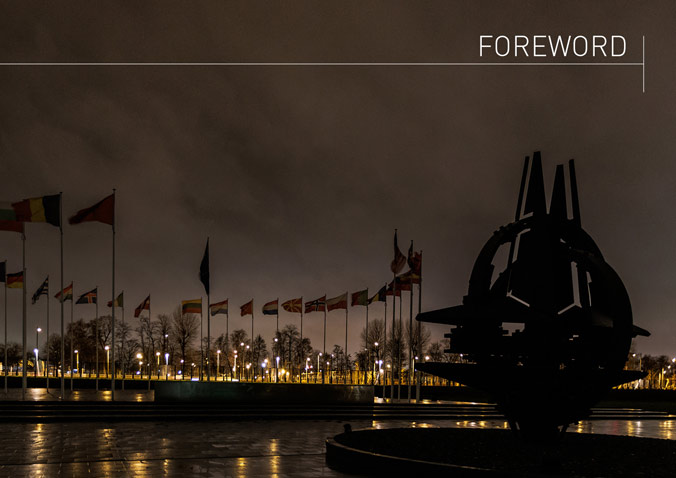
NATO Headquarters joins other international landmarks in switching off lights on 21 December in solidarity with Ukraine. Brussels, Belgium, December 2022.
Foreword
President Putin's war of aggression against Ukraine is the biggest security crisis in Europe since the Second World War. It is not only a direct threat to the existence of Ukraine as a free and independent country, but to the entire rules-based international order. Putin must not win. If he does, it will show that aggression works and that force is rewarded. This would be dangerous for our own security, and for the whole world.
This war did not start in 2022, it started in 2014, when Russia illegally annexed Crimea and entered eastern Ukraine. Since then, NATO Allies have trained tens of thousands of Ukrainian soldiers and supported its defence and security sector. NATO will continue to stand by Ukraine for as long as it takes.
NATO Allies shared precise intelligence about Moscow's plans for an invasion long in advance. We tried until the very last minute to engage Russia in diplomacy to convince it not to invade Ukraine, including at a meeting in January 2022 of the NATO-Russia Council. Russia walked away from this dialogue.
Since the invasion, NATO Allies provided unprecedented support for Ukraine, with around USD 120 billion of military, humanitarian and financial assistance in 2022. While the United States is the largest single contributor, Europe and Canada provided over half of the overall assistance. Europeans also welcomed almost five million refugees from Ukraine. Europe and North America continue to apply unprecedented economic sanctions. This demonstrates the strength of North America and Europe standing together.
Since 2014, NATO has implemented the largest reinforcement of our collective defence in a generation. It meant that when Russia launched its fully-fledged invasion of Ukraine, NATO was ready. We activated our defence plans within hours, doubled the number of NATO's multinational battlegroups from four to eight, and increased our military presence from the Baltic to the Black Sea, on the land, at sea and in the air.
In June 2022, at NATO's historic Madrid Summit, Allies agreed a further fundamental shift in our deterrence and defence to make clear that we will defend every inch of NATO territory. We upgraded our defence plans, put more forces at high readiness, and pre-assigned forces to defend specific Allies. We committed to station more troops and preposition more equipment and weapon stockpiles in the east of the Alliance. And leaders agreed to significantly increase NATO's Common Funding to ensure that our political decisions are supported with adequate resources.
In Madrid, Allies also agreed a new Strategic Concept, NATO's guiding document, to reflect this new security reality. Our new Strategic Concept identifies Russia as the most significant and direct threat to Allied security, it addresses the People's Republic of China for the first time, and it sets out how we address other challenges like the ongoing threat of terrorism, as well as cyber, hybrid, new technologies and the implications of climate change on our security.
At the Madrid Summit, all 30 Allies took the historic decision to invite Finland and Sweden to join the Alliance and, in the fastest accession process to date, 28 Allies have already ratified their accession.
Looking ahead to the NATO Summit in Vilnius in July 2023, we will continue to strengthen our deterrence and defence and adapt our Alliance to a world of strategic competition, where authoritarian regimes are challenging the rules-based international order. I expect Allies will agree a new more ambitious defence spending pledge. In a more dangerous world, Allies increasingly see 2% of Gross Domestic Product spent on defence as a floor and not a ceiling.
The bond between Europe and North America remains rock solid. More than 80% of citizens polled by NATO in 2022 believe that cooperation between our two continents on security matters is important.
In these more challenging times, NATO Allies stand united in our support of Ukraine, and in defence of our values, our nations and our one billion people. One for all and all for one.
Jens Stoltenberg
NATO Secretary General
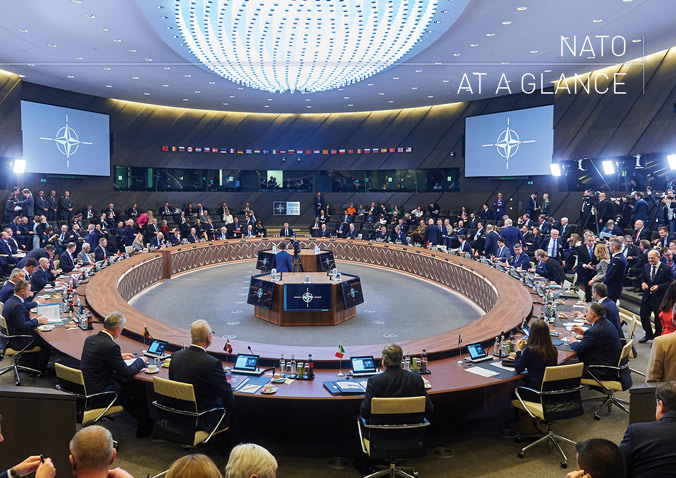
Meeting of the North Atlantic Council at the level of NATO Heads of State and Government during the extraordinary Summit following the onset of the Russian invasion of Ukraine. Brussels, Belgium, March 2022.
NATO at a Glance
Together, NATO Allies represent one billion people and roughly half of the world's economic and military might.
Why Was NATO Founded?
The North Atlantic Treaty Organization was founded in 1949 in the aftermath of the Second World War. Its essential purpose is to safeguard the freedom and security of all its members by political and military means. The principle of collective defence is at the very heart of NATO's founding document – the North Atlantic Treaty. This principle, enshrined in Article 5 of the Treaty, binds NATO Allies together, committing them to protect each other against attack. NATO strives to secure a lasting peace in Europe, based on common values of democracy, individual liberty and the rule of law.
How Many Member States Are There?
The Alliance started with 12 founding members: Belgium, Canada, Denmark, France, Iceland, Italy, Luxembourg, the Netherlands, Norway, Portugal, the United Kingdom and the United States. The North Atlantic Treaty allows other European countries to join the Alliance, as long as all Allies agree. Any prospective member must share NATO's core values and have the capacity and willingness to contribute to security in the Euro-Atlantic area. Over the decades, the following 18 countries have joined NATO: Greece and Türkiye (1952), Germany (1955), Spain (1982), Czechia, Hungary and Poland (1999), Bulgaria, Estonia, Latvia, Lithuania, Romania, Slovakia and Slovenia (2004), Albania and Croatia (2009), Montenegro (2017) and North Macedonia (2020). All 30 NATO Allies are stronger and safer together than they would be alone. In 2022, Finland and Sweden submitted official letters of application to become NATO Allies. In July, after completing accession talks, NATO Allies signed the Accession Protocols for Finland and Sweden, which then became Invitees, attending NATO meetings as such. Once all Allies have ratified the Accession Protocols according to their national procedures, the Secretary General will invite Finland and Sweden to accede to the North Atlantic Treaty, after which they will become NATO Allies.
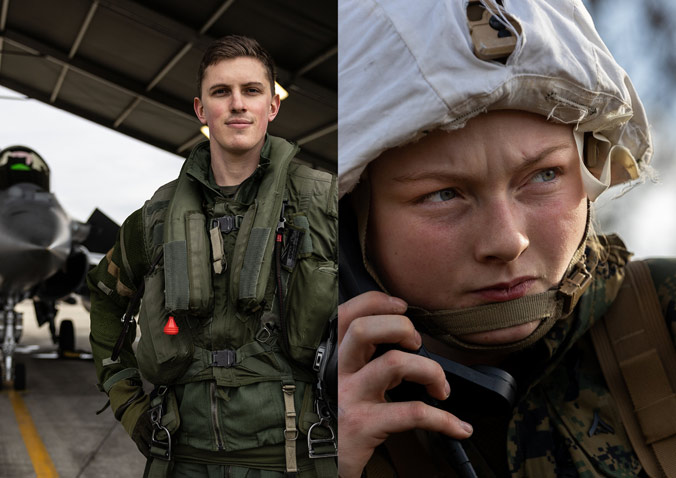
French Lieutenant "Balek" at Mont-de-Marsan Air Base, France, 2022 (left) and a US marine in exercise Cold Response 22. Sandstrand, Norway, March 2022 (right).
For All Who Serve
2022 has been a year like no other.
Russia's illegal war of aggression against Ukraine has made our world more dangerous. Faced with the biggest security crisis in Europe since the Second World War, NATO has responded with strength and unity.
With our defence plans activated within hours of the invasion, we now have over 40,000 troops under NATO command in the eastern part of the Alliance, backed by substantial capabilities in the air and at sea. We have doubled the number of battlegroups, from four to eight. And we will continue to strengthen our deterrence and defence.
What you, our armed forces, do sends a clear message to Moscow and to anyone who would challenge us: NATO is here. We will protect and defend every inch of our territory.
Over the past year, I have had the privilege to meet many of you, and I have seen how professional, committed and capable you are.
Wherever you are deployed – from the North Atlantic to the Mediterranean, maintaining a safe and secure environment in Kosovo, or helping security forces in Iraq – you play an essential role for our security.
I thank you very much for your service.
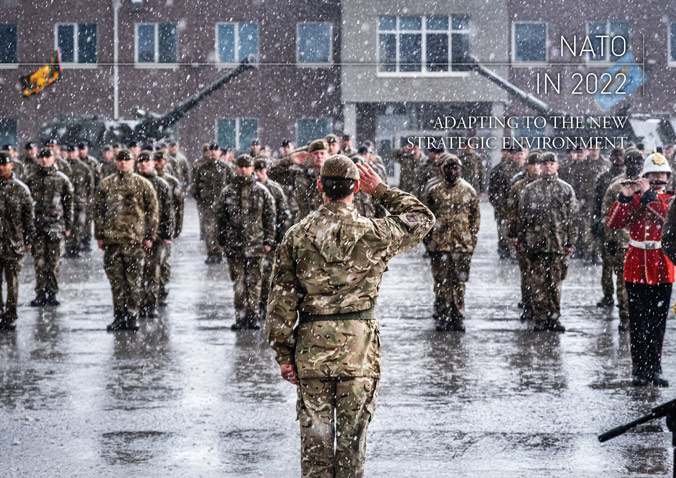
Estonian, French and UK soldiers mark the fifth anniversary of NATO's multinational battlegroup in Estonia. May 2022.
NATO in 2022: Adapting to the New Strategic Environment
Responding to Russia's Aggression
For more than 30 years, NATO tried to build a partnership with Russia. Despite this, over the past decade, Russia has continuously violated the norms and principles that contributed to a stable and predictable European security order.
Russia's brutal and unlawful war of aggression against Ukraine in February 2022 has shattered peace and gravely altered the security environment.
In light of its hostile policies and actions, NATO cannot consider Russia to be a partner. The Russian Federation is the most significant and direct threat to Allies' security and to peace and stability in the Euro-Atlantic area. However, NATO remains willing to keep open channels of communication with Moscow to manage and mitigate risks, prevent escalation and increase transparency. NATO does not seek confrontation and poses no threat to Russia.
In 2022, the Alliance continued to respond to Russian threats and hostile actions in a united and responsible way.
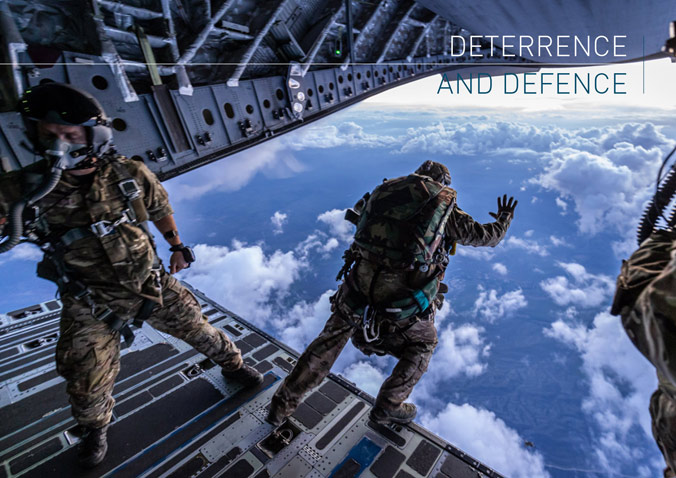
British Army Pathfinders leap from 18,000 feet as part of exercise Swift Response 22. North Macedonia, May 2022. Photo credit: British Army photographer Corporal Rob Kane.
Deterrence and Defence
A New Baseline for Deterrence and Defence
Russia's war of aggression against Ukraine constitutes the gravest threat to Euro-Atlantic security in decades. In response to a more complex and volatile security environment, in the 2022 Strategic Concept, Allies committed to significantly strengthening the Alliance's deterrence and defence posture to deny any potential adversary any possible opportunities for aggression. At the Madrid Summit, they took concrete decisions to set a new baseline for the Alliance's deterrence and defence posture. The updated posture will enable NATO to continue to protect Allied populations and defend every inch of Allied territory at all times. This new baseline is in line with NATO's 360-degree approach and aims to strengthen the Alliance's posture across the land, air, maritime, cyber and space domains and against all threats and challenges.
The new baseline builds on the ongoing military adaptation efforts, including the full and speedy implementation and operationalisation of two high-level military concepts – the Concept for the Deterrence and Defence of the Euro-Atlantic Area and the NATO Warfighting Capstone Concept. The Concept for the Deterrence and Defence of the Euro-Atlantic Area focuses on force employment to deter and defend today, while the NATO Warfighting Capstone Concept offers a vision to guide the Alliance's long-term warfare development to remain militarily strong now and in the future.
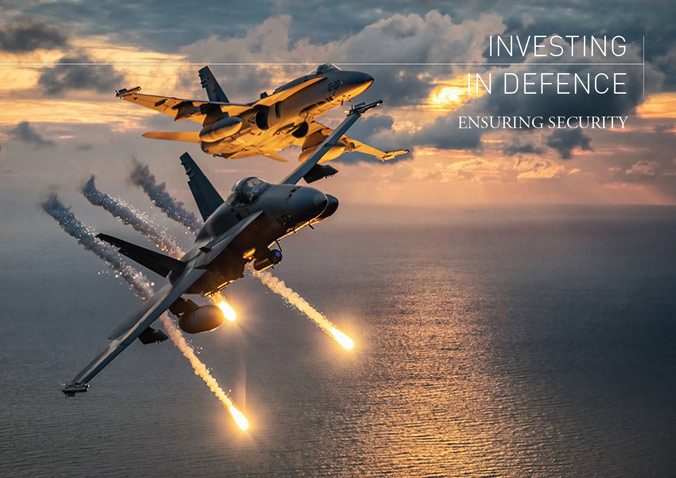
Spanish Air Force F-18 fighter aircraft patrol the Lithuanian skies during a training exercise of the Baltic Air Policing mission. Above the Baltic Sea, July 2022. Photo by Hesja Air-Art Photography.
Investing in Defence: Ensuring Security
In 2022, war has returned to the European continent. Allies at the 2022 Madrid Summit reaffirmed their commitment to the Defence Investment Pledge in its entirety. They agreed that they will build on that pledge and decide the following year on subsequent commitments beyond 2024. Investing in defence is essential to ensure the security and defence of all Allies, across the land, air, maritime, cyber, and space domains, and against all threats and challenges.
European Allies and Canada have increased defence spending for the eighth consecutive year. From 2021 to 2022, defence spending increased by 2.2% in real terms. In total, over the last eight years, this increase added USD 350 billion for defence.
In 2022, seven Allies met the guideline of spending 2% of their Gross Domestic Product on defence. In 2014, only three Allies met the guideline. The United States accounted for 54% of the Allies' combined GDP and 70% of combined defence expenditure. Total NATO military spending in 2022 was estimated to exceed USD 1 trillion.
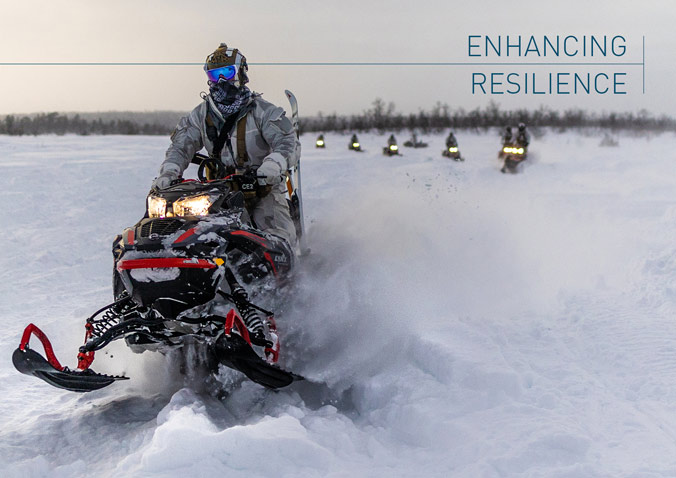
United States Army Special Forces soldiers assigned to the 10th Special Forces Group drive snowmobiles to navigate the deep snow of the Swedish Arctic in preparation for exercise Cold Response 22, a Norwegian-led multinational exercise that helps NATO Allies train for military operations in the High North. Swedish Arctic, February 2022.
Enhancing Resilience
Improving Allied and Collective Resilience
The 2022 NATO Strategic Concept delivered a clear strategic vision for NATO's resilience in a contested and unpredictable international security environment. Allies committed to strengthening their capacity to prepare for, resist, respond to and quickly recover from strategic shocks and disruptions. The Strategic Concept stresses that collective and national resilience is essential and underpins each of NATO's core tasks.
NATO employs a range of tools to bolster collective and national resilience. Conducting regular assessments is one of them. Assessments are fundamental for identifying areas of progress and challenges to be addressed. In 2022, NATO started a new resilience planning and review cycle with the endorsement of the 2022 Resilience Assessment. The assessment describes the state of NATO's overall collective resilience and outlines progress in seven areas, called the baseline requirements. The findings will inform measures taken to address the identified gaps and enhance the Alliance's overall resilience.
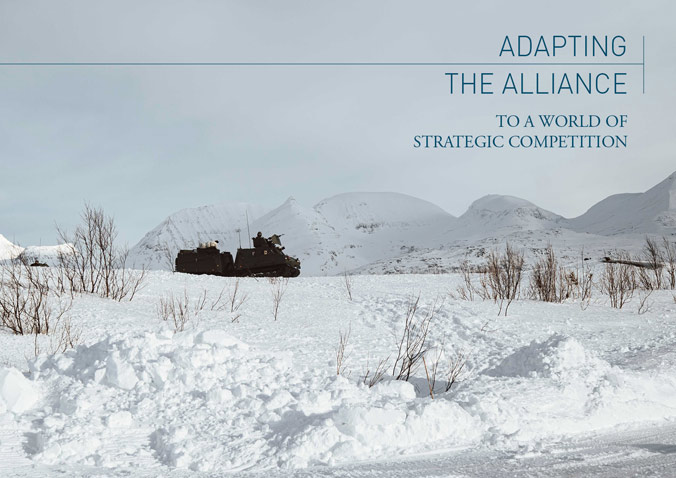
UK Royal Marines cross a hill in the Viking amphibious all-terrain vehicles during cold weather training near Bardufoss, Norway on 24 February 2022.
Adapting the Alliance to a World of Strategic Competition
Investing in Cutting-Edge and Interoperable Capabilities
NATO carries out a vast range of multinational missions and tasks, for which it requires interoperable, cutting-edge and cost-effective capabilities. The Alliance is the ideal forum for encouraging Allies to pursue the development, acquisition and maintenance of capabilities. To support Allies in this endeavour, NATO developed a number of High Visibility Projects. These projects address one or more key NATO defence planning priorities and provide Allies with dedicated staff support across the full project life cycle. This multinational approach has enabled Allies — and, in some instances, partners — to close key capability gaps across the board, save money and ensure interoperability by design.
In 2022, several projects reached key milestones and contributed significantly to NATO's strengthened deterrence and defence posture on the eastern flank.
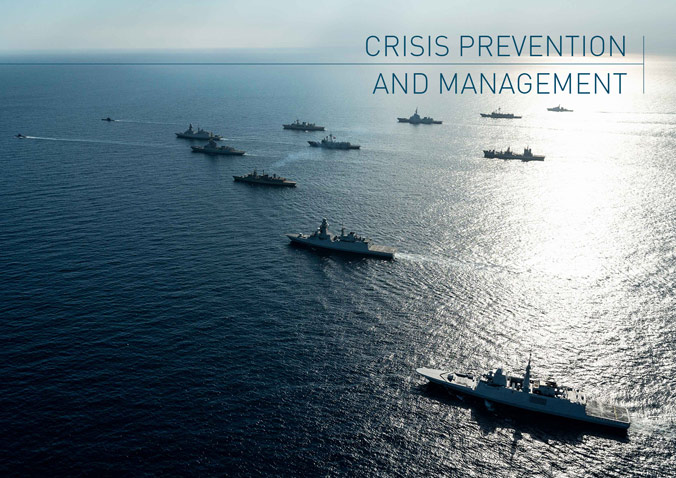
Ships taking part in exercise Dynamic Manta 2022. Off the coast of Sicily, Italy, March 2022.
Crisis Prevention and Management
Crisis prevention and management is one of NATO's three core tasks. The 2022 Strategic Concept stresses that Allies have a shared interest in contributing to stability and managing conflicts together, through NATO. The Alliance is committed to preventing and responding to crises when these have potential to affect Allied security.
Prevention of crises and conflicts is a sustainable way to contribute to stability and Allied security. NATO is committed to crisis prevention, including through training and capacity-building programmes that contribute to making partners more capable, more secure and better prepared to respond to crises at home and abroad. The Alliance has decades' worth of accomplishments in building defence institutions and capacity with partners in NATO's neighbourhood and beyond.
NATO also has unique capabilities and expertise in crisis management, including to coordinate, conduct, sustain and support multinational crisis response operations.
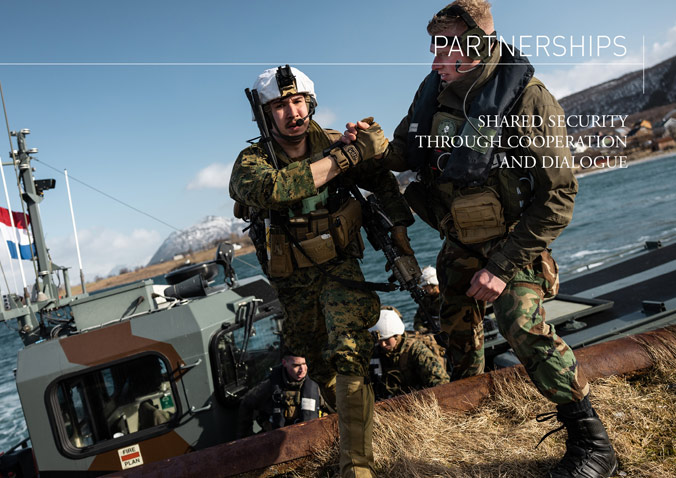
A Dutch amphibious reconnaissance marine helps a US marine off a Dutch landing craft during exercise Cold Response 22, which included more than 30,000 troops from 27 NATO member and partner countries. Near Sandstrand, Norway, March 2022.
Partnerships: Shared Security through Cooperation and Dialogue
NATO's partnerships are essential to the way NATO works. They are founded on mutual respect, interest and benefit. Partnerships contribute to stability in the Euro-Atlantic area and beyond and support NATO's three core tasks. Central to the protection of the global commons, they enhance NATO's resilience and sustain the rules-based international order.
NATO has active partnerships with 37 countries worldwide and several international organisations.
In 2022, NATO continued to enhance political dialogue and practical cooperation with partners on issues of common interest while remaining flexible and adapting to changing geopolitical realities.
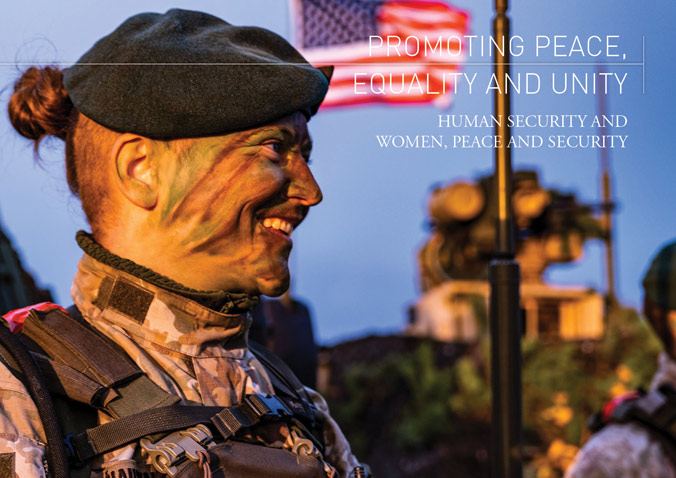
A Lithuanian soldier participates in exercise Iron Wolf. Lithuania, September 2022.
Promoting Peace, Equality and Unity – Human Security and Women, Peace and Security
Against the backdrop of Russia's war against Ukraine and the devastating effects of the tactics employed by Russian forces on Ukrainian civilians, NATO continued to show leadership in advancing its Women, Peace and Security and human security priorities throughout 2022.
For the first time, the NATO Strategic Concept reflects that Women, Peace and Security and human security are "cross-cutting" areas of work that must be integrated in all three core tasks of the Alliance. In the Strategic Concept, Allies committed to promoting good governance and integrating climate change, human security and the Women, Peace and Security agenda across all tasks. In addition, they undertook to "advance gender equality as a reflection of our values."
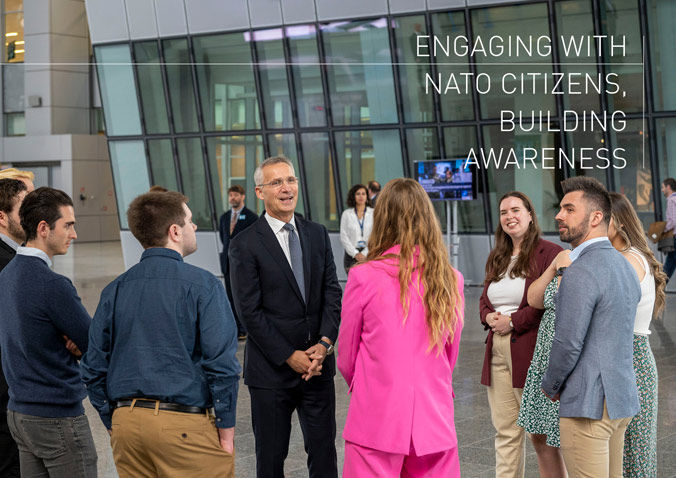
Secretary General Jens Stoltenberg meets with Protect the Future content creators at NATO Headquarters. Brussels, Belgium, May 2022.
Engaging with NATO Citizens, Building Awareness
2022 Communications Highlights
A strong and successful Alliance depends on the support and understanding of its citizens.
NATO achieves this through tailored communications and engagement with a wide range of international media and key opinion formers, as well as through digital outreach on multiple platforms. In addition to engaging citizens and explaining what NATO is and what it does to ensure our security, NATO also works to counter hostile information, including disinformation. NATO's approach relies on fact-based, credible public communications.
In 2022, clear, calm, credible and proactive communications have been central to every stage of NATO's response to Russia's war of aggression against Ukraine. Since the autumn of 2021, NATO publicly communicated on Russia's military build-up and their plans for a full-scale invasion of Ukraine, systematically exposing the Kremlin's false claims. At the same time, NATO conveyed clearly that the Alliance would protect and defend every inch of NATO territory.
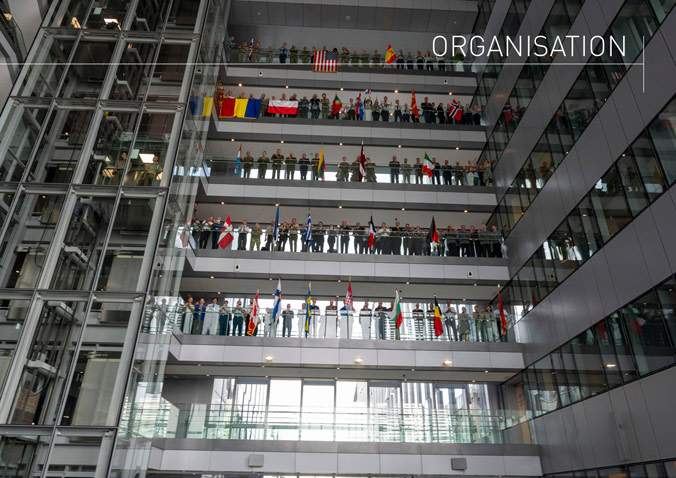
NATO International Military Staff and NATO Military Representatives gather at NATO Headquarters to bid farewell to the outgoing Director General of the International Military Staff, Lieutenant General Hans-Werner Wiermann. Brussels, Belgium, June 2022.
Organisation
NATO Headquarters
NATO Headquarters in Brussels houses the Alliance's International Staff and International Military Staff, along with 30 Allied delegations and military representations, 18 partner missions and staff from several NATO agencies. It is the central forum for the discussions and consultations that shape NATO policy and practice.

Kosovo Force (KFOR)
The NATO-led KFOR mission is to contribute to maintaining a safe and secure environment and freedom of movement for all communities in Kosovo, as mandated by United Nations Security Council Resolution 1244 of 1999. In carrying out its activities, NATO cooperates with and assists the United Nations, the European Union and other international actors, as appropriate, to support the development of a stable and peaceful Kosovo. KFOR also supports the development of professional, democratic and multi-ethnic security structures in Kosovo.
Read this annex in the Annual Report (PDF)
Defence Expenditure of NATO Countries (2014–2022)
NATO collects defence expenditure data from Allies and publishes it on a regular basis. Each Ally's Ministry of Defence reports current and estimated future defence expenditure according to an agreed definition. The amounts represent payments by a national government that have been or will be made during the course of the fiscal year to meet the needs of its armed forces, those of Allies or of the Alliance. In the figures and tables that follow, NATO also uses economic and demographic information available from the Directorate-General for Economic and Financial Affairs of the European Commission and the Organisation for Economic Co-operation and Development.
